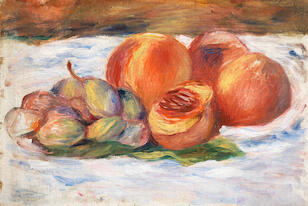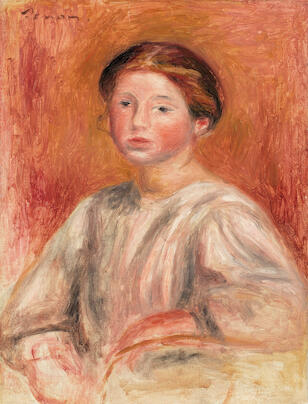The 1917 Revolution and subsequent Russian Civil War were key events in Chagall's artistic development. 20 years later – having moved to Paris in 1923 from his home town of Vitebsk – he embarked on his Révolution series. Over several, similarly structured, works, Chagall juxtaposes political upheaval, represented by the revolutionaries on the left side of the canvases, with artistic and domestic harmony in the form of musicians, roof tops, animals and lovers on the right. Separating these two worlds, the figure of Lenin is shown performing a handstand on a table, at which sits a rabbi contemplating the Torah.
Chagall returned to the theme in the years following World War Two. Being Jewish, he had fled France after the German invasion of 1940, and lived in America until 1948 when he returned to the country he saw as home. Autour de 'La Revolution 1937' was painted at some point between 1945-1950, and is a reflection on the earlier series (the title translates as Around 'The 1937 Revolution'.) The tone is markedly apolitical and lighter. The figure of Lenin has been replaced by an acrobat – a favorite Chagall motif - and the rabbi is now an elderly violinist. The revolutionary crowd has shrunk to a small group of banner-waving protestors.
Bonhams Global Head of Impressionist and Modern Art India Phillips commented: "After the Second World War, Chagall made a deliberate decision to emphasize beauty and peace. From exile in New York, he had followed the fate of European Jewry with mounting horror. Unlike many of his contemporaries, however, he chose to process his reaction to this unimaginable suffering through determined and conscious optimism."
Renoir


